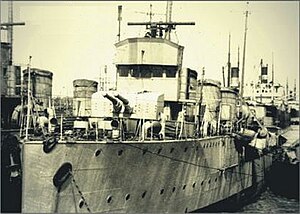NMS Mărăști
 |
|
| History | |
|---|---|
|
|
|
| Name: | Sparviero |
| Ordered: | 1913 |
| Builder: | Pattison Shipyard, Naples |
| Commissioned: | 1917 |
| Out of service: | 1920 |
| Fate: | Transferred to Romania, 1920 |
|
|
|
| Name: | Mărăști |
| Namesake: | Battle of Mărăști |
| Commissioned: | 1920 |
| Out of service: | 1944 |
| Refit: | 1925, Galați shipyard |
| Reinstated: | 1945 |
| Fate: | Deleted, 1964 |
|
|
|
| Name: | Lovkiy |
| Commissioned: | 1944 |
| Out of service: | 1945 |
| Fate: | Returned to Romania |
| Service record | |
| Commanders: | Deleanu Eugen (World War II) |
| Operations: | |
| Victories: |
|
| General characteristics | |
| Class and type: | Vifor-class destroyer |
| Displacement: |
|
| Length: | 94.7 m (310 ft 8 in) |
| Beam: | 9.5 m (31 ft 2 in) |
| Draft: | 3.6 m (11 ft 10 in) |
| Propulsion: | Tosi turbines, 5 Thornycroft boilers, 2 shafts, 48,000 horse power |
| Speed: | 38 knots (70 km/h) |
| Range: |
|
| Complement: | 146 |
| Armament: |
|
NMS Mărăști was a Vifor-class destroyer, ordered by Romania from Italy and built during the First World War. She spent most of her career in Romanian service, during World War II she and her sister being some of the most heavily-armed warships of the Romanian Navy and of the Axis Powers in the Black Sea. After one year in Soviet service, she was returned to Romania and continued to be used until 1964.
Like her three sister ships, she was ordered in 1913 by Romania from the Pattison Shipyard in Naples, with the name Vijelie. Designed by engineer Luigi Scaglia and based on Romanian specifications, she was to be a large destroyer armed with three 120 mm guns, four 75 mm guns, five torpedo tubes, and have a 10-hour endurance at full speed, as she was required to operate in the limited perimeter of the Black Sea. However, she was interned by Italy on 5 June 1916, when the country joined the First World War, and completed as scout cruiser (esploratori), being commissioned as Sparviero on 15 July 1917. She was transferred to Romania along with one of her sister ships, Nibbio, on 1 July 1920. She was renamed Mărăști and her sister was renamed Mărășești.
The cruiser measured 94.7 meters in length, with a beam of 9.5 meters and a draught of 3.6 meters. She was powered by Tosi turbines and five Thornycroft boilers, generating an output of just over 48,000 hp powering two shafts, which gave her a top speed of 38 knots. She was armed with three 6-inch (152 mm) Armstrong naval guns, four 3-inch (76 mm) Ansaldo guns, two 6.5 mm machine guns and two twin 457 mm torpedo tubes. She had a crew of 146 and a range of 1,700 nautical miles at 15 knots, as well as 380 nautical miles at 34 knots.
...
Wikipedia
